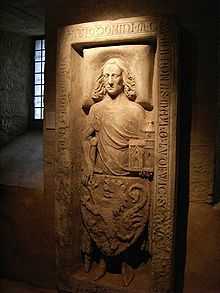Louis the Springer
| Louis the Springer | |
|---|---|
 Louis' grave stone in the Wartburg | |
| Spouse(s) | Adelheid of Stade |
| Noble family | Ludowingians |
| Father | Louis the Bearded |
| Mother | Cecliy of Sangerhousen |
| Born | 1032 |
| Died | 1123 |
| Buried | Wartburg |
Louis the Springer (German: Ludwig the Springer), sometimes called Louis the Jumper,[1] also known as Louis of Schauenburg (1042 – 1123 in Reinhardsbrunn) was a German nobleman. He was the ruling count of Thuringia from 1056 until his death. Little is known about him, although he is mentioned in many legends.
Life
Louis was a son of Louis the Bearded and a member of the Franconian noble Ludowingians dynasty. He was baptized in the parish church in Altenbergen (today part of Leinatal). Around 1080, Louis and his brother Beringe founded the Schönrain Priory. In a document dated 1100, the two brothers are called of Schauenburg, after a castle which their father had built near Friedrichroda.
It is generally assumed that Louis the Springer built the Wartburg, which became the nucleus of the Landgraviate of Thuringia. Louis himself did not use the title of Landgrave; his son Louis I was the first member of the dynasty to use that title.
According to legend, Louis received his nickname "the Jumper" when he boldly leaped into a river. He was attempting to take possession of the County Palatine of Saxony, that is, the area west of the river Saale and north of the Unstrut. To this end, he stabbed the ruling Count Palatine, Frederick III. He was arrested and incarcerated in Giebichenstein Castle in Halle. After three years in captivity, he expected to be executed. He escaped by leaping from the castle tower into the river Saale, where a servant was waiting for him with a boat and his favourite horse, a snow-white horse named Swan. As atonement for murdering Frederick, he built the St. Ulrici church in Sangerhausen and later he founded Reinhardsbrunn Abbey, which became the family abbey of the Ludowingians.
Another legend relates how he came to build the Wartburg. He found the location in 1067, while he was hunting in the area. How saw the mountain and exclaimed: Wait, mountain, thou shalt bear me a castle!. However, this mountain was outside his territory. To circumvent this problem, he had his men carry dirt from his own territory and dump it on the mountain. He then had twelve of his most loyal knights stand on that spot, stick their swords in the ground and swear that the soil they were standing on, rightfully belonged to Louis.
Louis was a prominent opponent of the Salian emperors Henry IV and Henry V during the Investiture Controversy.
Legacy
Wolfgang Hartmann has proposed the hypothesis that, considering his hostile stance towards the Salians, among the statues of famous church founders in the Naumburg Cathedral there must be statues of Louis and his wife.
Marriage and issue
Louis married Adelheid of Stade, the widow of Count Palatine Frederick III of Saxony. Together, they had the following children:
- Herman
- Louis I (d. 1140)
- Henry Raspe I (d. 1130)
- Udo I, bishop of Naumburg (d. 1148)
- Kunigunde
- Cicilia (d. 1141), married Count Gerlach I of Veldenz
- Adelaide, married Ulric II, Margrave of Carniola
- Conrad
Footnotes and references
- ↑ "Jumper" is a more accurate translation.
- Wilfried Warsitzka: Die Thüringer Landgrafen, Verlag Dr. Bussert & Stadeler, 2002, ISBN 3932906225
- Wolfgang Hartmann: Vom Main zur Burg Trifels — vom Kloster Hirsau zum Naumburger Dom. Auf hochmittelalterlichen Spuren des fränkischen Adelsgeschlechts der Reginbodonen, in the series Veröffentlichungen des Geschichts- und Kunstvereins Aschaffenburg e.V., vol. 52, Aschaffenburg, 2004.
- Karl Robert Wenck (1884), "Ludwig der Springer", Allgemeine Deutsche Biographie (ADB) (in German) 19, Leipzig: Duncker & Humblot, pp. 589–590
|
External links
| Wikimedia Commons has media related to Ludwig the Springer. |
- Literature by and about Louis the Springer in the German National Library catalogue
- Entry at genealogie-mittelalter.de
- About the book Vom Main zur Burg Trifels